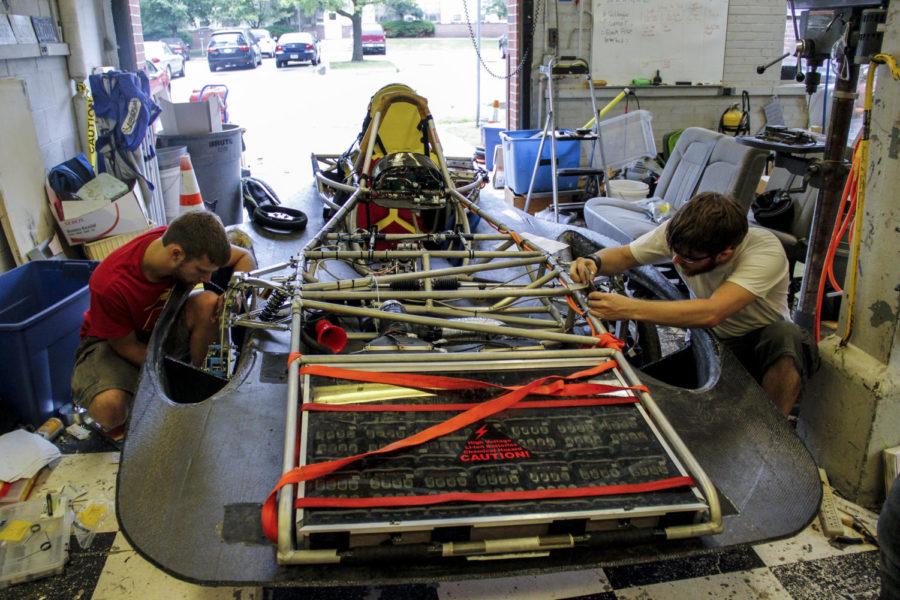Team PrISUm prepares for qualifiers
Kelby Wingert/Iowa State Daily
Team PrISUm members Ryan Hupp, senior in aerospace engineering, and Dakota Morgan, senior in mechanical engineering, work on the solar car Phaeton on July 11 in preparation for the American Solar Challenge cross-country road race July 21 to 28.
July 16, 2014
The PrISUm solar car team from Iowa State will compete in the American Solar Challenge road race July 21 to 28. The eight-day race will cover more than 1,700 miles from Austin, Texas, to Minneapolis, Minn., including a checkpoint stop in Ames on July 26.
The team left Ames with its car, named Phaeton, to head down to Austin on July 12 to finish preparing for the race.
Before the solar cars can race, they must pass car inspections, driver tests and a qualifying track race at the Circuit of the Americas in Austin from July 14 to 19.
According to the challenge’s website, the solar cars will go through a “series of inspections covering all aspects of the car: mechanical, electrical, body and sizing and dynamic testing.” These inspections, which happen over the course of three days, are meant to ensure all the cars are built in accordance to regulations and have all the required safety features to ensure the car is safe to drive on the roads.
Ryan Hupp, senior in aerospace engineering, will be one of four drivers for Team PrISUm. He said there is a lot to focus on when driving the solar car on the roads.
“You have to be aware of all the other cars and you don’t have great visibility,” Hupp said.
The inspections, called scrutineering, will also test the drivers of the cars. The drivers are required to get out of the car without assistance in 10 seconds or less to pass the egress test. They are also tested on the car’s braking, turning and stability as well as driving experience. The team must pass all the inspections before it can race.
Hupp said he is not worried about his team passing the egress test.
“I’ve done it a couple of times,” Hupp said. “I did it without the topshell and I could do it in about five seconds, so I think 10 seconds should be achievable.”
The qualifying race, called the Formula Sun Grand Prix begins July 17. The three-day track race at the Circuit of the Americas is won by the team with the most completed laps.
Each car must complete a minimum number of laps to qualify for the road race, and the total number of laps determines the starting order for the challenge. The tight turns in the track will test both the car’s stability and the driver’s skill.
Logan Scott, recent ISU graduate in computer engineering, said he isn’t aware of any big weaknesses in the car, but they hadn’t tested out the solar array — the panel covering the top of the car — before leaving for Texas.
“Usually, if you haven’t tested something out, it probably doesn’t work yet,” Scott said. “So we might need to do some debugging to make sure the array is verified. It’s kind of important for a solar car.”
The race begins July 21 at the University of Texas at Austin. The race will go through Texas, Oklahoma, Kansas, Nebraska, Iowa and Wisconsin before finishing in Minnesota.
A checkpoint will be set up in Ames on July 26. Each car is required to stop for at least one hour at the checkpoint. Scott said the Ames checkpoint will be set up in the parking lot at Hilton Coliseum and the cars will arrive at around 3 or 4 p.m.

















